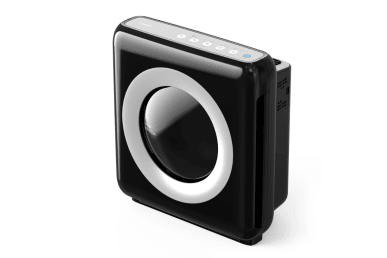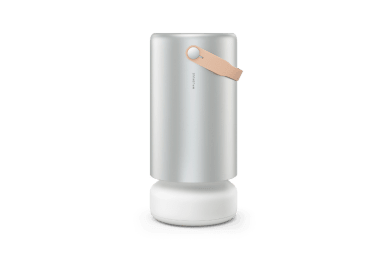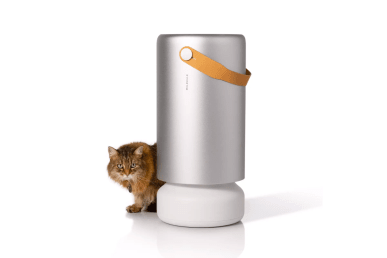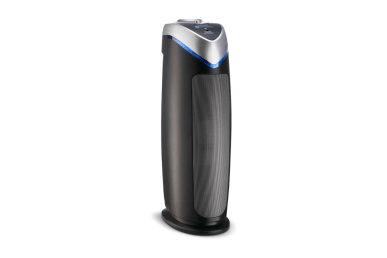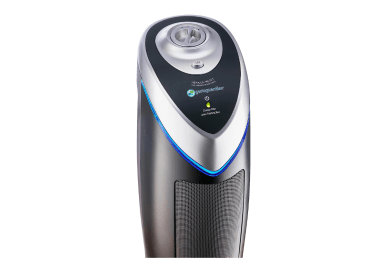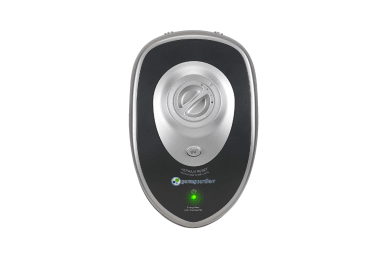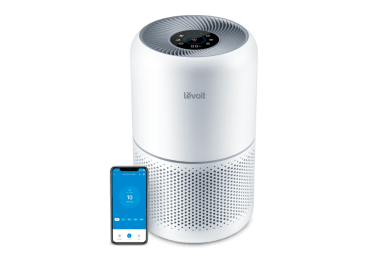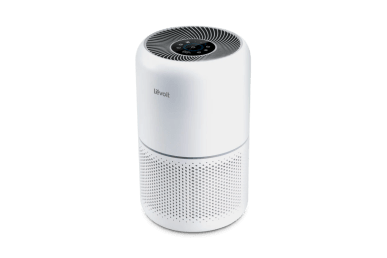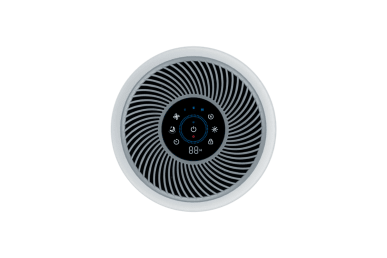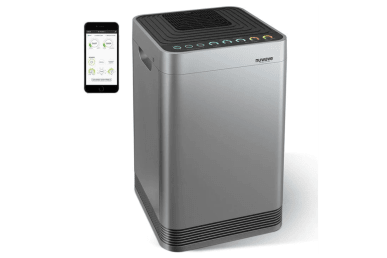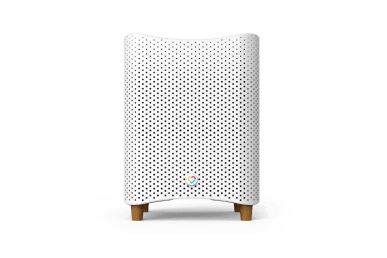Advertisement
The 7 Best Air Purifiers For Mold Of 2025 To Keep Your Air Clean & Fresh


If not handled properly, mold can live in the air around us and on surfaces in our homes, putting us at risk of physical and mental health problems such as brain fog1, anxiety, and chronic fatigue2—but an air purifier can tackle these airborne spores before they become a problem.
Experts say the best air purifiers for mold are those that use a HEPA filter, as they are able to capture 99.97% of particles up to 0.3 micron. We selected air purifiers based on this criteria, while also considering cost, design, coverage, and Clean Air Delivery Rating (CADR).
Shop our top picks below and learn other ways to prevent (and spot!) mold in your home.
- Best for mold & allergies: Coway Airmega AP-1512HH Mighty
- Best for destroying mold:Molekule Air Pro
- Best with washable filter: Blueair Blue Pure 211+
- Best for musty smells:GermGuardian AC4825
- Best for mold & dust mites:Levoit Core 300S
- Best for basements:NuWave OxyPure Smart Air Purifier
- Best design: Mila
We're big fans of the Coway Airmega and also selected it as one of the best air purifiers for allergies. This machine has four stages of filtration for purification you can feel confident about.
Why we picked it
Why we picked it
In addition to its reliable HEPA filter, there is a pre-filter for pet hair and larger dust particles, a carbon deodorizer filter for smoke and food smells, and an optional ionizer that aims to tackle the smallest particles in the air. In fact, research suggests that negative air ions could help people in relieving symptoms of allergies to dust, mold spores, and other allergens. The purifier’s auto-mode automatically adjusts between settings to purify your space as needed. To conserve energy, the eco-mode turns off after the air quality is purified for 30 minutes or mote, turning back on as soon as air pollution is detected.
Pros & cons
Pros & cons
Pros
- 4-stage filtration
- Timer and Eco-mode settings
Cons
- Carbon filter refills are tricky to find
- Brightness can be disruptive
With a PECO-filter, this air purifier destroys mold spores rather than trapping them on the filter's surface. According to the brand's research, it also helps rid your air of viruses, bacteria, allergens, and pollutants. In independent laboratory tests, the filter was found to effectively remove 99.9% of airborne mold spores within two hours of operation. It has a touch display and a corresponding app, which can be used to control the machine's features and view air quality and air score.
Why we picked it
Why we picked it
The brand touts its air purifiers for being incredibly quiet, at just 33 decibels on the lowest setting and 64 on the highest, and our commerce editor can attest to this. "I've tried other air purifiers that get the job done, but are a bit disruptive from a noise perspective," she says. "The Molekule is slightly more expensive, but definitely the quietest model I've tested—and it's the most aesthetically-pleasing." On the downside, the filters need to be replaced fairly regularly: every 3 months for the pre-filter and every 6 months for the PECO-filter.
Pros & cons
Pros & cons
Pros
- Destroys mold rather than trapping it
- Quieter than others we've tested
- App to track air quality and control settings
- Covers up to 1,000 square feet
Cons
- Filter replacements are expensive
A solid, Energy Star-rated purifier with a washable pre-filter, this aesthetically-pleasing design grabs larger dust particles and comes in several color options to match your space.
Why we picked it
Why we picked it
The main HEPA filter snags smaller particles (like mold spores, dust mites, and pollen), while a layer of activated carbon sucks in odors and VOCs.
Great for anyone who doesn’t want to deal with an app or display, this is one of the most straightforward picks on our list: there’s only one button to switch between three speeds, and an LED light that tells you when it’s time to change your filter.
Pros & cons
Pros & cons
Pros
- Washable pre-filter
- Energy efficient
Cons
- No timer or air quality display
This lower-priced pick uses four-stage filtration to keep your air fresh. It has a HEPA filter for smaller particles, pre-filter for larger particles, and charcoal filter for odors—which makes it a great choice if you're dealing with musty smells in your home.
Why we picked it
Why we picked it
There’s a built-in UV-C light, which the brand says kills airborne viruses, germs, and mold spores. It’s a harsher design than some others on our list—but for the lower price, you may not mind. Plus, the filter refills are less expensive, too!
Some negative reviews mention a plastic-like smell when this purifier runs, especially when it’s new, but it does seem to go away with time.
Pros & cons
Pros & cons
Pros
- Budget-friendly price
- 4-stage filtration
Cons
Cons
- May emit a plastic smell when new
- Mixed reviews about lifespan
For a compact option that doesn’t skimp on features, the Levoit Core 300S is a great pick. It's so good at removing tiny particles, we also included it in our picks of the best air purifiers for dust.
Why we picked it
Why we picked it
The standard filter uses a 3-stage filtration system that includes a pre-filter for larger gunk, a HEPA filter those small particles, and an activated charcoal filter for odors and gasses. Plus, the brand's refills are relatively inexpensive (around $30), and you’ll only need to change them every 6-8 months. Complete with an app, this purifier offers sleep mode (for quieter use), a timer, and an on/off display.
A few reviews suggest that this purifier might not have the longest lifespan. Additionally, some say while it started quiet, the machine got louder over time.
Pros & cons
Pros & cons
Pros
- Affordable replacement filters
- Over 75,000 ratings on Amazon
Cons
- Mixed reviews about lifespan
- May get louder over time
If you want to cover a lot of ground (specifically in larger areas, like your basement), this purifier packs a punch
Why we picked it
Why we picked it
The baseline coverage is 515 square feet, but a handful of reviewers say it’s effective in rooms more than twice that size (up to 1,200 square feet). Plus, it comes on wheels so you can easily transport it around your space.
The brand has an optional companion app to control this purifier and view your room’s status no matter where you are. The machine uses 5-stage filtration, has six fan speeds, several timer options, an auto mode, and a display that tells you the air quality status in the room.
Pros & cons
Pros & cons
Pros
- On wheels
- Effective for larger spaces
- 5-stage filtration
Cons
- Large
Can an air purifier be…cute? This brand certainly thinks so. With a companion app that gives you live status updates on your air quality, the Mila purifier is a smart device that works with Amazon Alexa and Google voice assistants.
Why we picked it
Why we picked it
The unit continuously monitors the humidity level in your room to alert you about possible mold growth, has a “Quiet Mode” that senses when you’re in the room, and even warns you about poor air quality outdoors.
The company sells several compatible HEPA filters, including a filter called “The Overreactor,” which is designed to grab even the smallest of particles.
Pros & cons
Pros & cons
Pros
- Connects with smart devices and has an interactive app to control settings from afar
- Monitors humidity levels to prevent mold growth
- Aesthetically pleasing
Cons
- Filters are expensive
- Mixed reviews about app features and notifications
How we picked
- Expert recommendations: We did extensive research and spoke with allergist Anjuli Mehrotra, M.D., to learn more about what to look for in an air purifier for mold. Each purifier on our list meets the suggested HEPA criteria.
- Design: Our main priority is choosing products that perform well and hold up over time. We also evaluated each pick for its design, aesthetic, sound level, and brightness display.
- Price: Because each product has different features and materials, air purifiers fluctuate in price. Our list offers a range of options, including a few budget-friendly picks.
- Variety: Air purifiers come in all shapes and sizes, and the best one for you depends on your preferences and the size of your space. We paid close attention to each machine’s coverage area, and have noted these details in our list below.
What to look for in an air purifier
HEPA status
HEPA filters (or High-Efficiency Particulate Air filters) are the only type that's certified to meet the U.S. Department of Energy's standards3. HEPA filters are able to capture 99.97% of particles up to 0.3 micron. However, the Department of Energy notes that the diameter specification of 0.3 micron responds to the worst case—HEPA filters are still extremely efficient when it comes to trapping particles that are larger or smaller than 0.3 micron.
Cost of filter replacements
Most air purifiers also include at least one additional layer of filtration with the HEPA filter. Depending on the design, this could mean carbon (or activated charcoal) filters that filter smoke, gases, and odors; pre-filters for larger particles; or ionizers to grab the smallest particles in the air. While additional filters can be helpful, you'll want to consider the cost of replacing them. Filter prices range from $30 to $100 for replacements, but the cadence in which you'll need to swap them out varies by machine.
Coverage, or CADR rating
Most air purifier brands provide a Clean Air Delivery Rating (CADR) to indicate how effective a product is at turning over the air in a given square footage. It's important to know the limits of each product so you can manage your expectations accordingly. Most brands give a numerical value or estimated square footage for the purifier's reach.
Do air purifiers help with mold?
Mold reproduces through tiny particles called mold spores4, which are invisible to the naked eye. Spores exist in indoor and outdoor air, but mold has the highest risk of growing indoors when these spores land on wet surfaces.
While most air purifiers won't eliminate the mold or mildew already growing on your surfaces, these machines help prevent mold spores from landing in the first place. "Top-rated air purifiers have the ability to remove small particles like spores, improving indoor air quality and reducing the chances for indoor mold growth, explains Michael Rubino, mold and air quality expert and author of The Mold Medic, an Expert's Guide on Mold Removal.
Allergist Anjuli Mehrotra, M.D., agrees. "Mold spores are usually under 40 microns in size, so air purifiers with HEPA filters can usually filter out airborne mold spores," she adds. Microns are a unit of measurement equal to one-millionth of a meter—to give you an idea of how small 40 microns is, one grain of beach sand is typically between 100 and 10,000 microns.
"Mold is actually present around us everywhere, both indoors and outdoors," continues Mehrotra. "It does not always cause health issues, but people with allergies and asthma may be more sensitive to molds causing symptoms like coughing, wheezing, or nasal symptoms like sneezing or congestion. Exposure to excessive amounts of mold via airborne mold particles may trigger irritation of the eyes, nose, skin, throat, and lungs. People with suppression of their immune system or chronic lung or respiratory disorders may be at increased risk of infection from mold."
"For those who are attempting to determine if an inspection is necessary, at-home options such as The Dust Test can begin to set the foundation for figuring out if there's a contamination situation present," Rubino adds.
When it comes to choosing the best air purifier for mold, Rubino says the key is to find a machine with technology that eliminates the particles from the air, so they don't just blow right back into the surrounding environment. "Air purifiers should at least meet HEPA status, meaning they remove 99.97% of particles as small as 0.3 micron. That being said, some species of mold can create microscopic toxins called mycotoxins, which are even smaller than mold spores. Finding air purifiers that can eliminate particles smaller than 0.3 micron can help cleanse the air further," he explains.
FAQ:
How do you know if you have mold in your house?
Rubino says all homes have some low levels of spores and microscopic particles, which can be actively removed through preventive actions such as deep cleaning, changing air filters, and investing in air purification. However, he adds that there's a marked difference in the volume of particles present when mold is actively growing inside your home.
"The best way to determine if you have mold growing in your home is to hire a qualified professional to come and inspect the building," Rubino explains. "This individual should spend hours carefully analyzing the home's interior and exterior and use various testing methodologies."
Other indicators of indoor mold growth include:
- Visible growth (make sure to check hotspots such as the basement, attic, appliances, crawl spaces, underneath sinks, and carpeting)
- Water damage
- An earthy, musty, stale, cigar-like odor
- Chronic health conditions with seemingly no root cause
Can you get rid of mold spores in a house permanently?
While mold spores can dry out, they will never entirely disappear unless professionally removed from your space. According to Rubino, your best bet at fighting mold spores is by integrating a purification system into your home's HVAC system. "As for what type of unit to opt for, whole-house air purifiers are the best because they're installed at the home's point of entry and help circulate filtered air throughout the entire building," he says.
"They also add a layer of protection for the HVAC system: Filtering out small particles like mold spores reduces the chance that growth begins in the unit. As the lungs of the home, mold growth in the system can lead to contamination being spread throughout the entire indoor space."
Is an air purifier or dehumidifier better for mold?
According to Rubino, it depends on the situation. "Some species of mold can grow in high humidity, which is why indoor humidity levels should remain between 35 and 50%," he explains. "If this can't be accomplished, a dehumidifier should be brought in to reduce those levels so that mold doesn't have the opportunity to grow. If humidity levels are in the safe zone, air purifiers can work to remove particles like mold spores from the air. This increases indoor air quality and decreases the chances of a spore opportunistically finding a space to begin growing. The fewer spores there are in a home, the better."
The takeaway
Clearing the air in your home from pollutants like dust, mold spores, and pollen is a worthwhile effort. Air purifiers make this task easier than ever.
Keep in mind, if you're concerned a small purifier won't fully detox your air, you may want to consider bringing in a professional. For mold on surfaces, check out our picks for the best natural mold killers.

